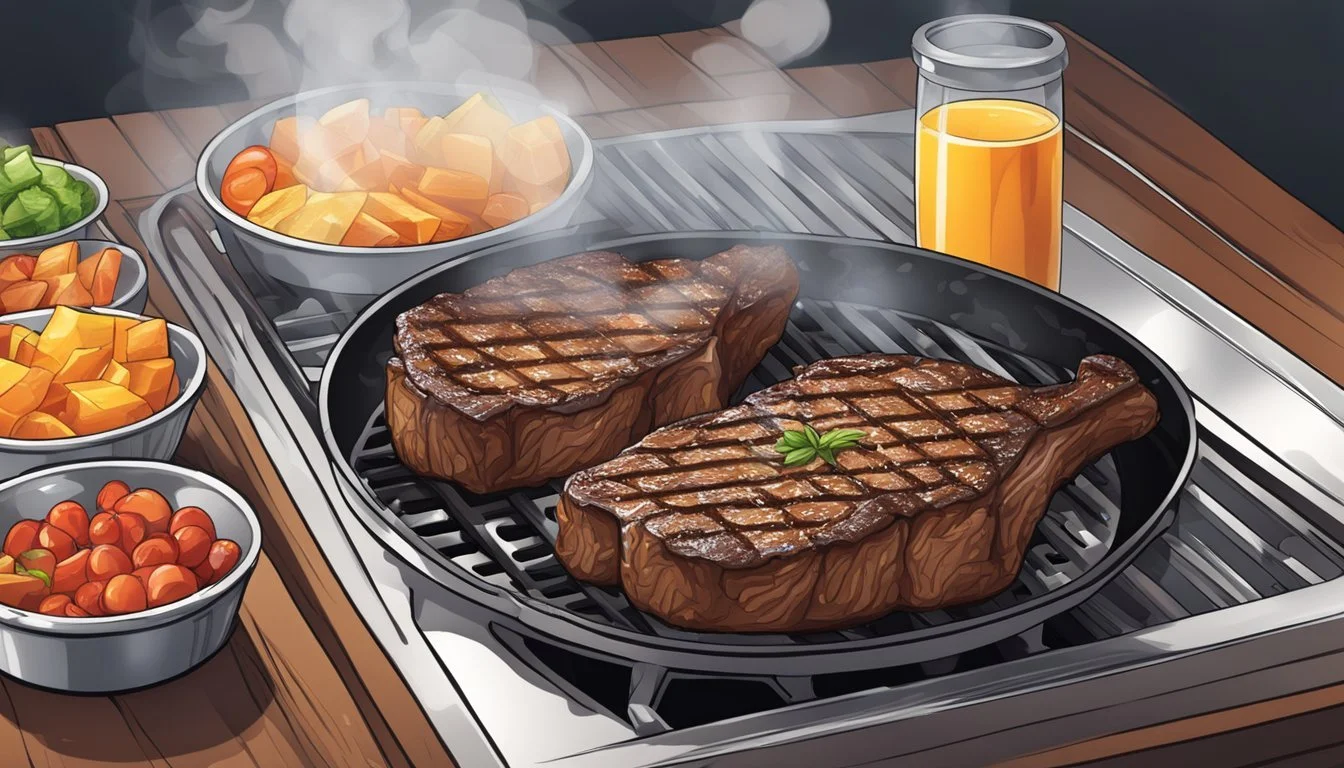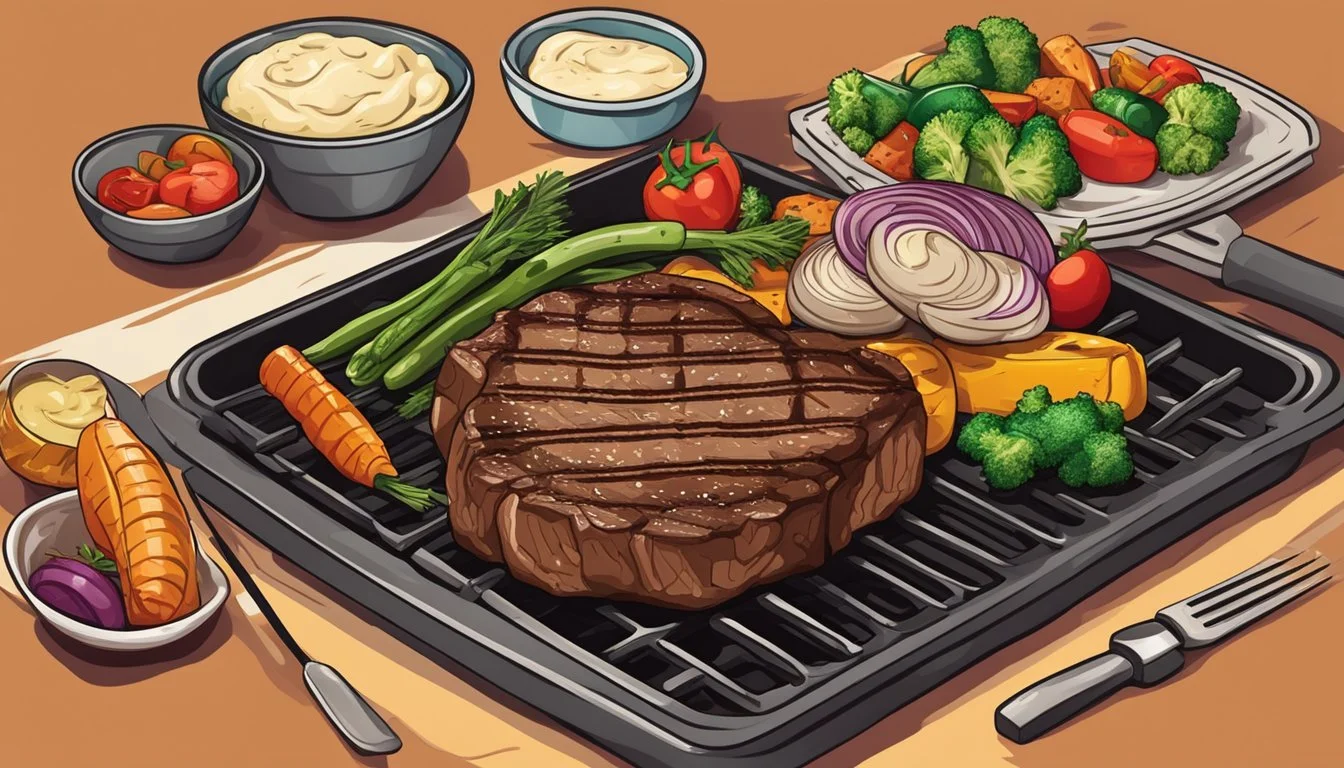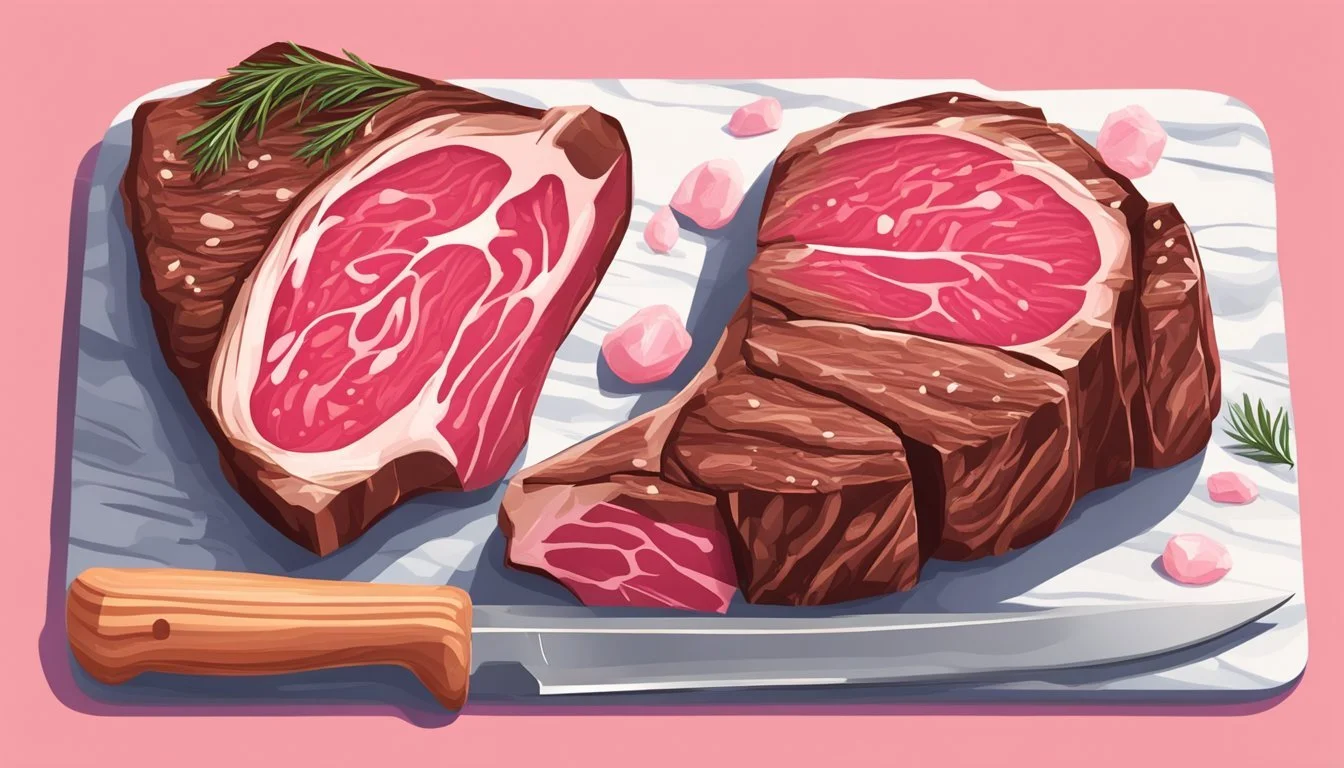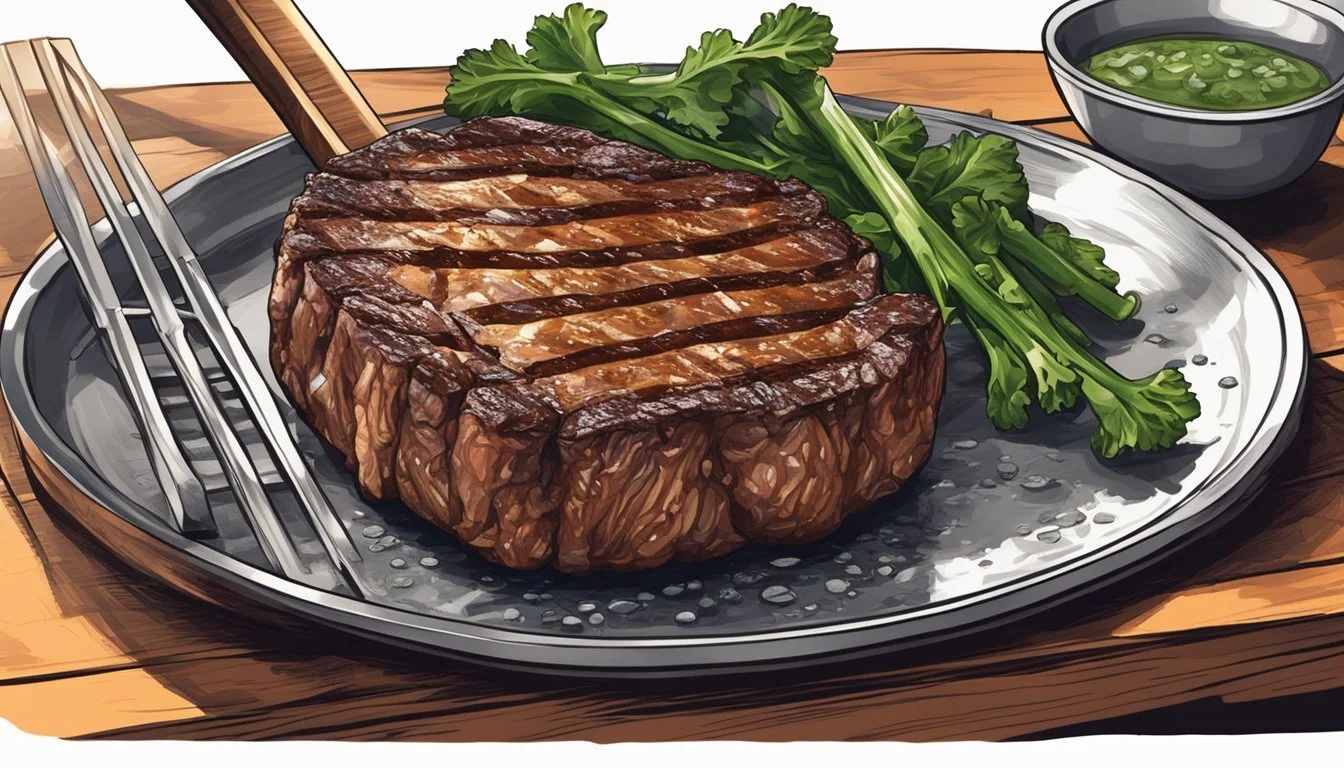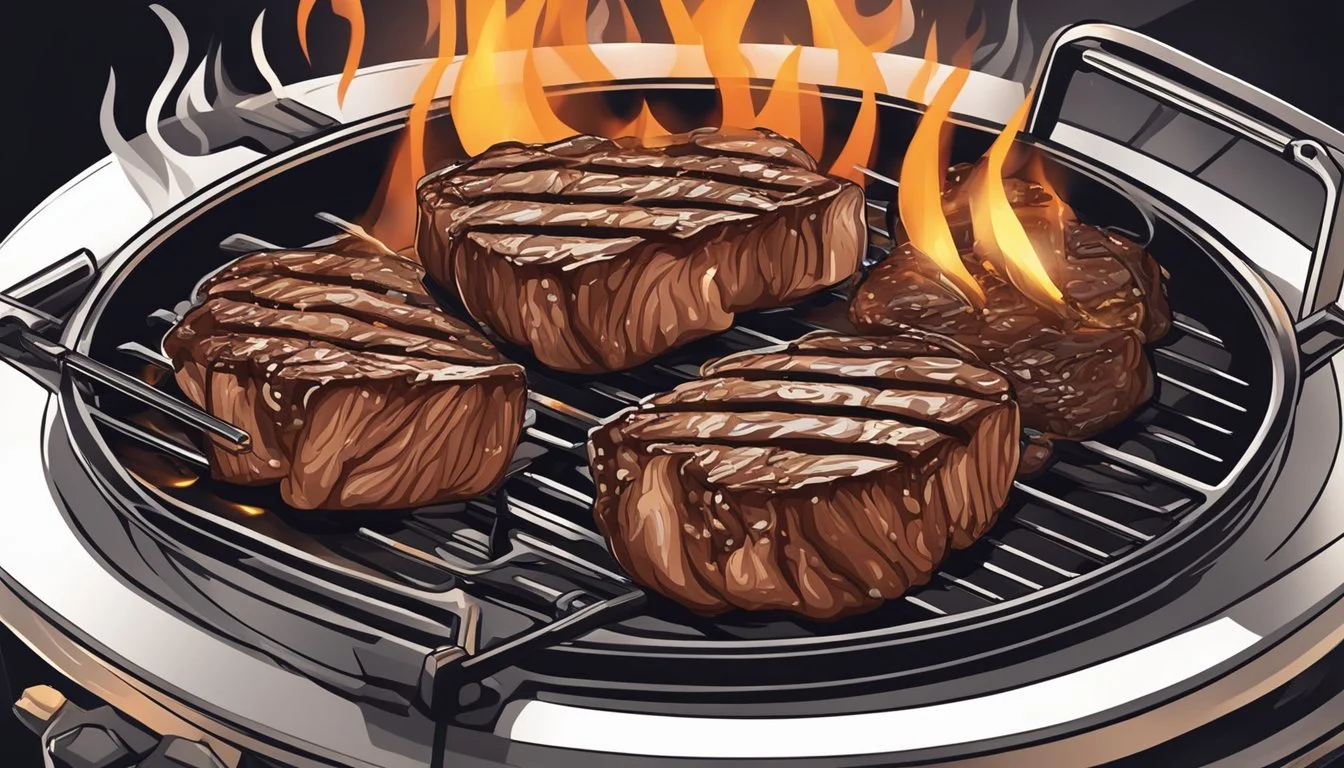How do you eat a ribeye steak?
Mastering the Art of Enjoying this Succulent Cut
Eating a ribeye steak (What wine goes well with ribeye steak?) is a culinary experience that combines taste, texture, and technique. Known for its marbling and rich flavor, a ribeye is a favorite among steak enthusiasts. The marbled fat within the ribeye ensures that each bite is juicy and full of flavor. To fully enjoy a ribeye steak, one should understand the proper methods of cutting and savoring this premium cut of beef.
When consuming a ribeye steak, one starts by assessing the doneness, which should align with personal preference, be it rare, medium-rare, or well-done. The steak is best enjoyed by cutting it against the grain, which leads to shorter muscle fibers and a more tender eating experience. Patrons are advised to include some of the succulent fat with each piece of meat, as the fat enhances the steak's flavor profile.
Diners often begin eating their steak from the center, where they can experience the truest taste of the meat. The center cut of the ribeye often contains the perfect balance of textures and provides a clear indication of the overall level of doneness. By carefully attending to these details and ensuring the steak is seasoned and cooked appropriately, the ribeye steak can be enjoyed to its fullest potential, providing a satisfying and delectable meal.
Selecting the Perfect Ribeye
When choosing a ribeye steak, connoisseurs focus on the cut's unique attributes, such as marbling and whether to opt for bone-in or boneless, to ensure a tender, juicy eating experience.
Understanding Ribeye Anatomy
The ribeye steak, also known as rib steak, rib-eye, or scotch fillet, comes from the rib section of the cow, specifically the upper rib cage. This area yields a cut of meat that is renowned for its rich flavor and tender texture due to the balance of muscle and fat. It's essential to recognize that ribeye steaks have a significant amount of intermuscular fat, known as marbling, which contributes to their succulence and taste.
Evaluating Marbling and Texture
Marbling refers to the white flecks of intramuscular fat distributed throughout the meat's muscle. Higher levels of marbling typically indicate a more flavorful and tender ribeye steak. When selecting a steak, one should look for even and abundant marbling throughout the cut. This fat will render during cooking, infusing the ribeye with a juicy flavor and contributing to a tender texture. A visit to a reputable butcher can provide access to high-marbling cuts, ensuring a superior culinary experience compared to standard grocery store selections.
Choosing Between Bone-In and Boneless
Ribeye steaks come in two main varieties: bone-in and boneless.
Bone-in Ribeye (Rib Steak): This type contains the rib bone and is often favored for the flavor imparted by the bone during cooking.
Boneless Ribeye: Lacks the rib bone which makes for a slightly less flavorful but more evenly cooked steak.
Some aficionados believe the bone can enhance the meat's flavor and juice retention, while others prefer the boneless option for its consistent cooking properties and ease of eating. Additionally, there's the Tomahawk steak, which is a bone-in ribeye with a long rib bone, giving it a distinctive look and providing the same advantages as a typical bone-in steak. The choice between bone-in and boneless often comes down to personal preference and the specific cooking method one intends to use.
Preparation Basics
Before searing a ribeye steak to perfection, one must focus on two critical preparation steps: letting the steak rest at room temperature and seasoning it properly for optimal flavour development.
Room Temperature Resting
Allowing the steak to rest at room temperature is crucial for a couple of reasons. First, it ensures more even cooking throughout, as a room temperature steak will cook more predictably than one that's cold. For a ribeye steak, this means removing it from the refrigerator and letting it sit for about 30-40 minutes before cooking.
Seasoning Your Steak
A ribeye's flavour can be significantly enhanced with proper seasoning. The recommended approach involves:
Salt: Kosher salt is an excellent choice as it adheres well to the meat's surface. Generously season both sides of the steak to taste.
Pepper: Freshly ground black pepper adds a complementary kick. Apply it alongside salt for the best results.
Optional Additions: While salt and pepper are essentials, one can also consider adding garlic, rosemary, or other preferred herbs and spices for an aromatic touch.
Oil: A high-smoke-point oil helps prevent sticking and contributes to forming a delicious crust. Olive oil or canola oil can be used, but one must ensure the skillet is hot before the steak and oil make contact.
By attentively managing these preparation basics, the steak is primed for cooking — a direct path to an exquisitely palatable experience.
Cooking Techniques
Selecting the right cooking technique is essential to bringing out the rich flavor and achieving the perfect doneness for a ribeye steak. Whether you prefer it rare, medium rare, or well done, understanding the nuances of each method ensures a delectable result.
Pan-Searing Ribeye
Pan-searing a ribeye on high heat creates a flavorful crust. Use a cast-iron skillet and let it heat until it's smoking. Season the steak with salt and pepper. Then, place it in the skillet without moving it for a few minutes, creating a deep sear. Flip with tongs and sear the other side. The steak should reach an internal temperature of 135°F for medium-rare.
Grilling the Perfect Steak
Grill a boneless ribeye by first heating your grill to high. Brush the steak with oils like canola or vegetable, and season well. Grill each side for 4-5 minutes for medium-rare, using tongs to flip. Let the steak rest afterward to retain juices.
Reverse Searing Method
Reverse searing starts with cooking the ribeye at a low temperature in the oven and then finishing it with a sear in a hot skillet. This technique is ideal for thicker cuts, ensuring an evenly cooked interior. Cook in the oven at around 275°F until the internal temperature is 10-15 degrees below your desired doneness. Then sear on high heat for a crusty exterior.
Oven Roasting Essentials
Roasting a ribeye in the oven involves preheating your oven to 500°F and placing the seasoned steak on a rack. Lower the heat to 325°F after putting the steak in, and roast until it's 5°F below your preferred internal temperature. Let it rest, covered, to continue cooking slightly.
Sous Vide for Optimal Control
Sous vide provides precise control over the doneness of your ribeye. Season the steak and place it in a vacuum-sealed bag. Submerge it in a water bath set to your desired temperature—for medium-rare, that's typically 129°F. Cook for 1 to 3 hours, and then quickly sear in a hot skillet to develop a flavorful crust.
Resting and Serving
When enjoying a ribeye steak, one must not overlook the importance of resting the meat post-cook and presenting it with complementary sides. This ensures a steak that is succulent to the last bite and an overall harmonious dining experience.
Importance of Meat Resting
Proper resting is crucial for a ribeye steak to reach its peak juiciness. After cooking, one should let the steak rest for approximately 5-7 minutes for regular cuts, and up to 10-12 minutes for thicker cuts. This pause allows the meat's fibers to relax and the juices to redistribute, ensuring each slice is equally succulent. It's recommended to use a thermometer to confirm the steak has cooled to about 120-125 F, and using tongs, transfer it to a warm plate to maintain temperature without cooking further.
Slicing and Presentation
Once rested, slice the ribeye against the grain, which means cutting perpendicular to the muscle fibers. This technique ensures tenderness. Thick slices can retain more heat, while thinner slices cool quicker but may present a more elegant look. If the steak has a bone or significant fat, it should be removed skillfully before serving. Present the slices on a preheated platter, garnish with fresh thyme or black pepper for aroma and visual appeal.
Pairing with Sides
Complementing a ribeye steak with appropriate sides can elevate the dining experience. A simple salad dressed with vinaigrette offers a fresh contrast to the steak's richness. For a heartier companion, mashed potatoes, creamy and smooth, balance the robust flavors and textures of the meat. If one prefers, roasted potatoes can replace mashed for a more textured side. Always select sides that can stand up to the steak's boldness without overshadowing it.
Advanced Tips and Tricks
In the pursuit of the perfect ribeye steak, certain techniques can elevate both flavor and texture significantly. These methods focus on enhancing the crust, infusing flavor through basting, and utilizing key aromatics during cooking.
Achieving a Crispy Crust
Initial Preparation: Pat the steak dry with paper towels before seasoning. Moisture is the enemy of a good sear.
Seasoning: Liberally season the steak with salt and black pepper.
To ensure a crispy crust:
Heat a cast iron skillet over high heat until it's very hot.
Add a thin layer of olive oil or canola oil to the skillet to create a non-stick surface.
Place the steak in the skillet only once the oil is shimmering to avoid sticking.
Press the steak down gently for even contact with the skillet.
Sear the steak without moving it for a few minutes until a crust forms before flipping.
Butter Basting for More Flavor
Choosing the Right Fat: Use a combination of olive oil to sear and butter to baste for added richness.
Basting Process: After the initial sear, add cubes of butter to the skillet, allowing it to melt and foam.
For optimal flavor:
Tilt the skillet slightly so the melted butter pools to one side.
Use a spoon to collect the butter and continuously baste it over the steak.
This technique not only adds flavor but also helps cook the steak more evenly.
Using Aromatics in Cooking
Aromatics: Add aromatics like garlic cloves, rosemary, and thyme to the skillet when butter basting.
Incorporating aromatics:
Crush garlic cloves with the skin on and add them to the skillet.
Toss in a sprig of rosemary and thyme to infuse the butter.
Continuously spoon the aromatic-infused butter over the steak, ensuring the flavors penetrate the meat.
Safety and Nutrition
When eating ribeye steak, it is important to consider both safety, particularly in terms of cooking the steak to an appropriate internal temperature, and the nutrition you're receiving from the cut of meat. These factors are essential to enjoying ribeye steak in a healthy and enjoyable manner.
Understanding Steak Doneness
Internal temperature is the most reliable indicator of steak doneness. A meat thermometer is a must-have tool for anyone looking to cook steak safely. The United States Department of Agriculture (USDA) recommends that steaks be cooked to a minimum temperature of 145°F for safety, followed by a three-minute rest time. However, personal preferences vary, and the doneness levels range from rare to well done.
Rare: A cool red center and an internal temperature typically around 125°F.
Medium Rare: A warm red center, often considered the optimal level of doneness for flavor and texture, usually at 135°F.
Medium: A pink and firm center, reaching an internal temperature of about 145°F.
Medium Well: Just a hint of pink in the center, with an internal temperature nearing 150°F.
Well Done: No pink, cooked through, and an internal temperature of 160°F or higher.
Using an instant-read thermometer or oven-safe meat thermometer can help ensure the desired level of doneness is achieved.
Health Benefits and Concerns
Ribeye steak is known for its rich flavor and nutritional content. It is an excellent source of protein and provides various essential nutrients:
Vitamins: Ribeye offers vitamins such as B6 and B12, which are important for energy metabolism and neurological health.
Minerals: Key minerals found in ribeye include zinc and selenium, which support immune system function, and iron, which is critical for oxygen transport in the blood.
However, it also contains higher amounts of saturated fat, which should be consumed in moderation. A 3-ounce serving of ribeye steak typically contains:
Calories: Around 250
Saturated Fat: Approximately 8 grams
Cholesterol: About 68 mg
Potassium: Roughly 221 mg
It's important to balance the intake of ribeye steak with other nutrient-dense foods that provide a variety of health benefits. Individuals should also be aware of their specific dietary needs and adjust their consumption accordingly.
Preservation and Leftovers
Proper storage and reheating techniques are key to preserving the taste and safety of ribeye steak leftovers. Whether one wants to enjoy the steak the next day or save it for a later date, certain methods help maintain its texture and flavor.
Proper Steak Storage
To maximize freshness and extend the shelf life of leftover ribeye steak, one must store it properly:
Refrigeration: Leftover steak should be placed in the refrigerator within two hours of cooking. For best results, an airtight container or plastic wrap should be used to prevent air exposure and moisture loss. Keeping steak at a constant refrigerated temperature reduces the risk of bacterial growth.
Freezing: For long-term preservation, one can freeze the ribeye. The steak should be wrapped individually and tightly in freezer paper, which provides a moisture barrier. Then, they should be placed in a heavy-duty freezer bag, laid flat to freeze evenly, and the air pressed out to reduce freezer burn.
Reheating Methods
Reheating leftover steak properly is just as important as storage to ensure the best possible flavor:
Oven/Skillet Combination: For a steak that’s medium rare to well done, a gentle and gradual reheating process works best. The steak can be warmed in an oven set at 250°F (121°C) until it reaches 110°F (43°C) internally. Afterward, a quick sear in a hot cast iron skillet with a bit of olive oil can recreate the original crust without overcooking.
Skillet Alone: For those who prefer a faster method, a skillet on medium heat can be used to warm the steak through. The steak should be flipped frequently and can be lightly coated with olive oil to enhance flavor. It’s important to allow the steak to rest for a few minutes after reheating to redistribute the juices.
Using these methods ensures ribeye leftovers can be enjoyed as if they were freshly cooked, whether one decides to reheat them as is, slice them thin for sandwiches, or toss them into a salad.
Understanding Steak Cuts
When selecting a steak, one's choice often depends on the desired balance between tenderness, flavor, and preferred cooking method. The ribeye is a prime example of a cut that offers a harmonious blend of these attributes.
Comparing Ribeye to Other Cuts
Ribeye: A cut from the rib section, it is known for being especially tender and flavorful due to its rich marbling. Ribeye can be purchased either bone-in or boneless, with the bone-in variety sometimes referred to as a rib steak.
Boneless Ribeye Steak: This is a ribeye cut without the rib bone, valued for its convenience and uniform cooking properties.
Bone-in Ribeye: Retaining the rib bone, this cut is sometimes called the cowboy steak and is prized for the added flavor the bone can impart.
Filet: Also known as filet mignon, this cut comes from the smaller end of the tenderloin; it is highly regarded for its tenderness but has less marbling compared to ribeye.
Skirt Steak: Coming from the plate section of the cow, skirt steak is less tender but boasts a strong beefy flavor.
Porterhouse: This is a larger cut that includes both the flavorful New York strip and the tender filet separated by a T-shaped bone.
New York Steak: Also known as the New York strip, this steak comes from the short loin and is leaner than ribeye but noted for its beefy taste.
Prime Rib: The prime rib is a larger cut that includes several ribeye steaks, often roasted as a larger piece to tender perfection, especially popular during holidays.
When comparing a ribeye to other cuts like the filet or skirt steak, the differences in texture and flavor profiles stem from the various parts of the cow from which they are cut, the amount of muscle use, and their fat content. Each cut has a unique character and is best suited to particular cooking methods and dishes, whether it's a quick searing on the grill for the ribeye or long, slow cooking for tougher cuts.
Enhancements and Condiments
When it comes to savoring a ribeye steak, the right enhancements and condiments can elevate the dining experience. The steak's rich flavors are complemented by selected sauces and toppings, which can range from classic to innovative additions.
Selecting the Right Sauces and Toppings
Choosing appropriate sauces and toppings involves considering the natural flavor profile of the ribeye steak. Here are some popular options:
Sauces:
Classic Butter: A simple dollop of melted butter, possibly infused with garlic, can enrich the steak's flavor.
Chimichurri Sauce: This vibrant, herby sauce adds a fresh kick with parsley, garlic, vinegar, and olive oil.
Red Wine Reduction: A reduction can accentuate the steak's robust taste without overpowering it.
Toppings:
Herbs: Fresh herbs such as rosemary and thyme can be finely chopped and sprinkled over the steak to enhance its aroma.
Spices: Freshly ground black pepper is a staple, delivering a subtle heat that complements the meat's natural savoriness.
These enhancements should be used judiciously to complement, not mask, the ribeye's inherent richness and tenderness, often highlighted by its marbling and occasionally by the flavor that bone-in cuts (ribeye with bones) offer.
Steakhouse Secrets
Steakhouses are renowned for their ability to consistently cook ribeye steaks to perfection. The keys to replicating this experience at home involve proper heat management, cooking tools, and carefully selected seasonings.
Mimicking a Steakhouse Experience at Home
To achieve the coveted steakhouse crust on a ribeye steak, one should use a cast iron skillet. This type of skillet distributes heat evenly, and when preheated properly, it sears the steak effectively, creating a flavorful crust.
Steakhouses often prefer cooking to a medium rare doneness to balance flavor and tenderness. They typically aim for an internal temperature of 130-135°F. It's important to let the steak rest after cooking to allow the juices to redistribute, ensuring each bite is succulent.
Herbs and seasonings are essential in a steakhouse's playbook. A simple but liberal seasoning with salt and pepper just before cooking can greatly enhance the steak's natural flavors. Adding herbs such as thyme and rosemary during the cooking process infuses the steak with aromatic undertones.
To replicate the intense, consistent heat of a professional grill, one must preheat the skillet over medium-high heat. It's crucial to turn the steak every 2-3 minutes for an even crust. Steakhouses also baste the steak with butter and herbs for additional flavor and moistness.
By following these tips, one can create a steakhouse-quality ribeye steak right in the comfort of their own kitchen.
Recipes and Inspiration
When it comes to dining on ribeye steak, flavor and technique are paramount. This section offers carefully selected recipes that showcase the ribeye's potential when paired with the right ingredients and methods.
Innovative Ribeye Steak Recipes
Ribeye Steak with Garlic Butter Veggies: For a succulent meal, one can cook a ribeye steak to a perfect medium-rare and serve it with a side of garlic butter veggies. Here's a brief guide:
Preparation: Season the steak generously with salt and pepper. Let it rest at room temperature for about 30 minutes before cooking.
Cooking: Heat a skillet over high heat and add oil. Place the seasoned steak in the skillet and let it sear undisturbed for about 4 minutes on each side for a nice crust.
Garlic Butter Veggies: Saute your choice of veggies— like asparagus, carrots, or green beans—in garlic butter until tender and season to taste.
Rest: Let the steak rest for at least 5 minutes before slicing to allow the juices to redistribute.
This ribeye steak recipe balances the rich, flavorful beef with the lightness and nutrition of seasonal vegetables, providing a well-rounded eating experience.
Garnishes and Sides
The ribeye steak, with its rich marbling and robust flavor, pairs excellently with a variety of garnishes and side dishes. These accompaniments can enhance the overall dining experience by balancing flavors and textures.
Choosing Complementary Vegetables
Vegetables: They play a critical role in complementing the savory depth of ribeye steaks.
Salad: A simple wedge salad with crispy bacon, cherry tomatoes, and blue cheese adds a refreshing crunch.
Carrots: Glazed carrots bring a sweet contrast to the steak's savoriness.
Green Beans: A side of green beans, either steamed or sauteéd with garlic, provides a healthy and flavorful crunch.
Opting for Starchy Side Dishes
Potatoes: No steak dinner is complete without the classic potato sides.
Mashed Potatoes: Creamy mashed potatoes serve as a soft bed to soak up the steak's juices.
Baked Potatoes: A fully loaded baked potato with sour cream, chives, and melted cheese offers a hearty complement.
Starchy side dishes like these not only add substance to the meal but also play well with the ribeye's richness, making them an essential part of the steak-eating experience.
Cookware and Tools
In the process of cooking a ribeye steak, the choice of cookware and precision tools can have a significant impact on the outcome of the dish.
Selecting the Best Cooking Equipment
When preparing a ribeye steak, a skillet is the primary tool used to create a delectable sear. Specifically, a cast iron skillet is highly recommended due to its superior heat retention and even cooking properties, which are essential for achieving a perfect crust on the steak.
For handling the meat in the pan, tongs are a better option than a fork as they do not pierce the meat, allowing it to retain its juices. A steady grip and gentle turn will ensure that the steak cooks evenly without any unwanted loss of fluids or flavor.
Monitoring the temperature of the steak is crucial for desired doneness. A meat thermometer or, more conveniently, an instant-read thermometer, is a crucial tool. It's advisable to aim for a few degrees below the target temperature as the steak will continue to cook after being removed from heat due to residual heat.
If an oven is being used for the cooking process, especially to finish the steak after searing, a skillet that is safe for both stovetop and oven use is required. In cases where a grill is incorporated, the equipment must accommodate high-heat and flame without damage.
For alternative cooking methods, an air fryer can be used, although it won't provide the same sear as a skillet. It's essential to ensure proper air circulation for the steak to cook evenly.
To summarize, quality cookware and precision tools such as a solid cast iron skillet, reliable tongs, and an accurate thermometer are the cornerstones for cooking a flawless ribeye steak.
Cooking Atmosphere
When preparing a ribeye steak, creating the right cooking atmosphere is as crucial as the cooking process itself. The ideal environment involves managing high heat conditions effectively and ensuring good ventilation to handle smoke that may arise from searing the steak.
Ensuring Proper Ventilation While Cooking
Cooking a ribeye requires a smoking hot pan to achieve a well-seared crust. As the steak cooks under high heat, oil in the pan can start to smoke. Proper ventilation becomes essential. Here are specific steps cooks should follow to maintain a smoke-friendly kitchen:
Open Windows: Before heating the pan, one should open windows to promote cross-ventilation. This helps to disperse smoke and lessen the chance of setting off smoke alarms.
Use an Exhaust Fan: If available, utilize the range hood's exhaust fan to its highest setting. This draws smoke and oil particles up and away from the cooking area.
Portable Fans: A portable fan can be positioned to blow air out of an open window, enhancing the ventilation provided by natural breezes.
These steps ensure a comfortable and safe atmosphere, conducive for expertly cooking a ribeye steak.

